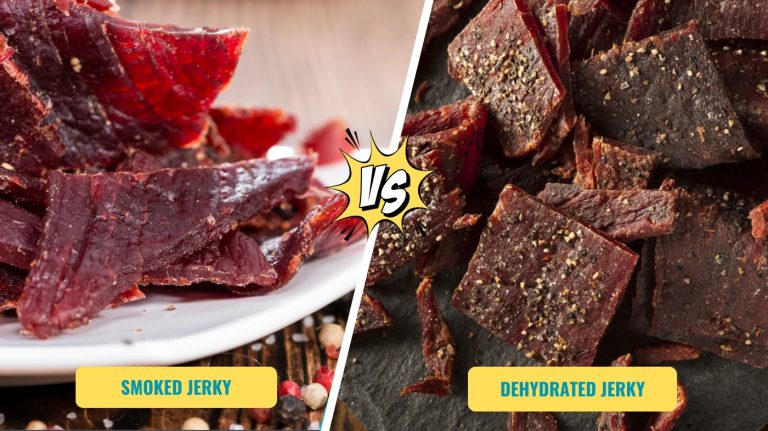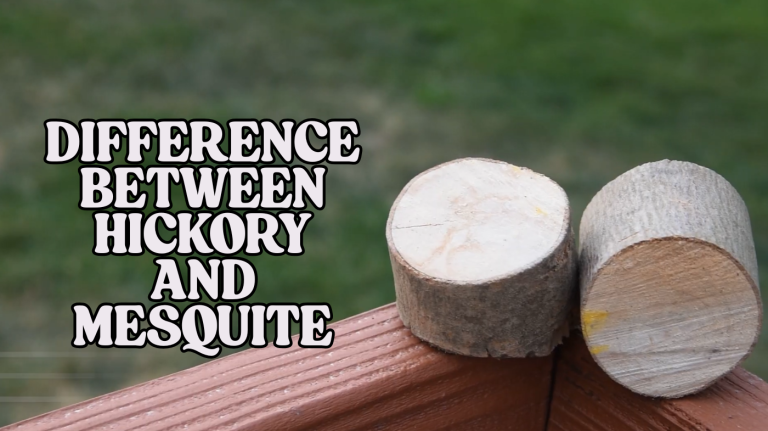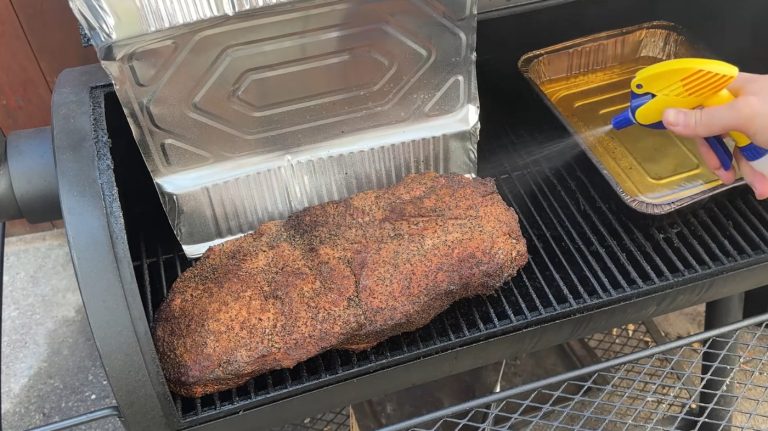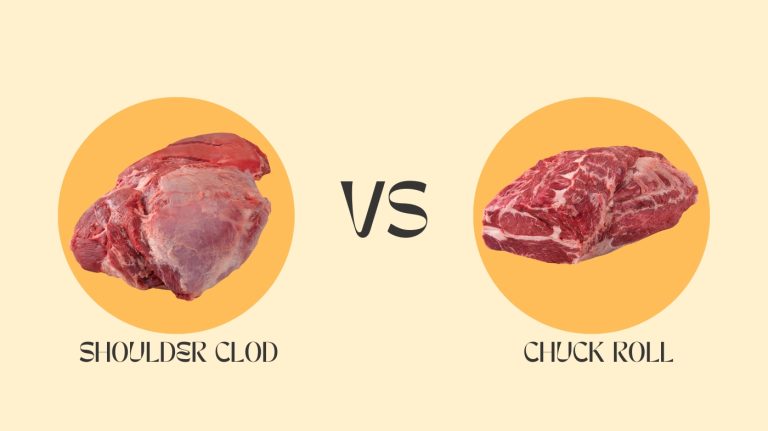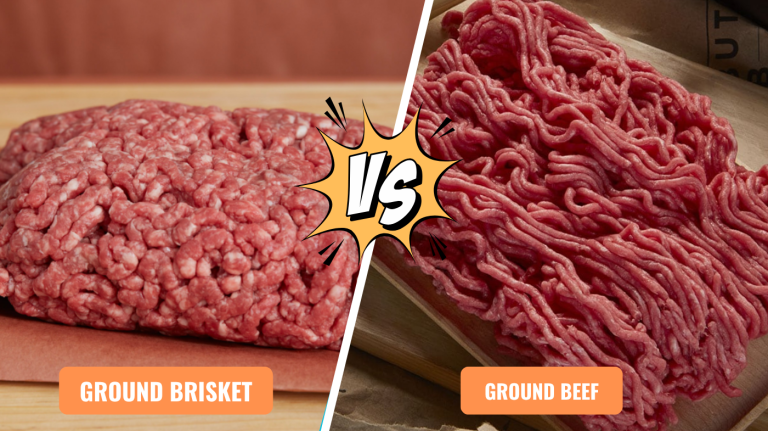Beef Plate Ribs vs Short Ribs: Which Cut Reigns Supreme?
When choosing between beef plate ribs and short ribs, know that plate ribs offer larger, fattier cuts ideal for low-and-slow smoking, yielding tender, flavorful meat rich in protein and fat.
Short ribs have more connective tissue, making them chewier but excellent for braising or quick grilling, especially in Korean cuisine.
Plate ribs are less common in stores, often sourced locally, while short ribs are widely available. Understanding these differences helps you select the best cut for your cooking style and taste preferences, with deeper insights available.
Key Takeaways
- Beef plate ribs are larger, fattier, and ideal for slow-smoking, while short ribs have more connective tissue and suit braising or quick grilling.
- Plate ribs offer higher protein content per serving and a tender texture when cooked low and slow compared to the chewier short ribs.
- Short ribs are versatile, popular in Korean and European cuisines, often marinated and sliced thin for grilling or braising.
- Plate ribs are less commonly available in stores, typically sourced from local butchers, whereas short ribs are widely accessible year-round.
- Consistent low-and-slow cooking preserves nutrients in both cuts, with plate ribs benefiting from resting wrapped in foil to retain moisture.
Origin and Location Differences
Although both beef plate ribs and short ribs come from the rib section of the cow, their origins and regional associations differ considerably.
Beef plate ribs have a distinct history rooted in Texas barbecue culture, gaining prominence in the 20th century at establishments like Louie Mueller Barbecue and Black’s BBQ in Lockhart.
These ribs are emblematic of Southern United States cuisine, specifically Texas, where they’re slow-smoked to develop bold flavors.
The rise of ribs in Texas and other parts of the South was influenced by the broader trend of barbecue evolving from whole animal cooking to focus on specific cuts, a shift driven by industrialization and refrigeration that made ribs more widely available as a desirable dish industrialization and refrigeration.
Beef plate ribs, iconic in Texas BBQ, are slow-smoked for rich, bold flavors at legendary spots like Louie Mueller.
In contrast, short ribs trace back to Eastern European Jewish cuisine, with dishes like Flanken highlighting their traditional use. They enjoy a global presence due to their adaptability in various ethnic cuisines, including Asian and European.
While beef plate ribs define Texas BBQ, short ribs have a broader, international culinary footprint, reflecting diverse cooking methods and cultural heritages.
Meat Content and Texture Comparison
When comparing beef plate ribs and short ribs, you’ll notice significant differences in meat content and texture that influence cooking methods and final taste.
Plate ribs offer a larger, more uniform slab of meat with higher fat content, especially near the rib cage end, which contributes to moistness and tenderness during cooking.
To retain this moisture and enhance tenderness, it’s important to cover with foil during cooking or reheating. In contrast, short ribs contain more connective tissue and a tougher grain structure, often resulting in a chewier texture.
Plate ribs yield more meat per bone and feature a more consistent grain, making them naturally tender. Short ribs, sourced from the chuck primal, require extended cooking to break down connective tissue. Plate ribs are often called dinosaur ribs due to their size and length.
Both cuts benefit from low-and-slow cooking, but their distinct meat composition demands precise handling to optimize texture and maximize flavor.
Ideal Cooking Techniques for Each Cut
Since beef plate ribs and short ribs differ in fat content and connective tissue density, you’ll need to apply distinct cooking techniques tailored to each cut’s characteristics.
For plate ribs, low and slow smoking at 275°F for 3–3.5 hours with dry rubs and finishing on the grill yields tender, flavorful meat.
Allowing the ribs to rest wrapped in foil and insulated after cooking helps enhance moisture retention and tenderness. Short ribs require membrane removal and the 3-2-1 method at 275–300°F for most desirable tenderness.
Spritzing maintains moisture in both cuts. When preparing short ribs, it is important to remove fat cap and silverskin to improve rub penetration and reduce excess fat.
| Cut Type | Temperature (°F) | Key Technique |
|---|---|---|
| Plate Ribs | 275 | Smoking + Grill Finish |
| Short Ribs | 275–300 | 3-2-1 Method + Spritz |
| Both | Low & Slow | Marinades & Dry Rubs |
Use these methods to maximize tenderness and flavor distinctively.
Availability and Preparation Tips
You’ll find beef plate ribs are rarely stocked in grocery stores, so sourcing them often means visiting specialty butchers or ordering online.
These ribs are typically large, meaty cuts from the short plate, often called “Dinosaur Ribs” due to their impressive size, which makes them a centerpiece for outdoor cooking.
When preparing short ribs, focus on their smaller bone size and versatile cuts like English or Flanken styles to optimize cooking methods.
Plate short ribs come from the 6th–10th ribs below the brisket, making them distinct from other rib types in both size and meat content.
Proper cooking techniques such as searing on medium-high heat and resting are essential to retain juices and enhance tenderness, similar to methods used for premium beef cuts like Wagyu beef.
Sourcing Beef Plate Ribs
Although beef plate ribs aren’t as commonly stocked in supermarkets as short ribs, you can find them through a variety of specialized sources that guarantee quality and freshness.
To source premium plate ribs, consider these options:
- Local Butchers and Specialty Shops – They often provide hand-cut, fresh plate ribs with superior marbling and can offer advice on selection. Their expertise can also help you choose cuts suited for efficient heating applications like low-and-slow cooking.
- Online Retailers – Platforms like Wild Fork and Tillman’s Meats supply trimmed, high-grade ribs, ensuring controlled quality and convenient delivery.
- Direct Farm Sales and Gourmet Stores – Sustainable and locally raised options are available, such as those from Cavallari Gourmet, enhancing flavor and traceability.
Choosing reputable suppliers ensures you get well-marbled, tender plate ribs ideal for low-and-slow cooking or grilling, maximizing their rich flavor and texture. These ribs are typically sourced from sustainable ranches in the Midwest, reflecting a commitment to quality and humane practices.
Preparing Short Ribs
While sourcing quality plate ribs establishes the foundation for a great meal, understanding the availability and preparation techniques for short ribs guarantees you maximize their potential.
Short ribs, available year-round and sold as English-cut or flanken-style, are accessible at supermarkets, butcher shops, and online retailers. Using a marinade can add layers of flavor reminiscent of traditional barbecue sauces, enhancing the meat’s taste profile.
To optimize cooking, trim excess fat to reduce time and improve texture. Marinate the ribs to infuse flavors, then consider dredging in flour for a crisp sear.
Season ribs with salt and pepper before dredging to enhance flavor and create a better crust. Employ temperature control rigorously, especially when braising or slow-cooking, to tenderize their rich collagen content.
After cooking, allow resting time for juice redistribution. These precise steps ensure you harness short ribs’ dense protein and flavorful fat, resulting in a tender, richly flavored dish that performs well across diverse culinary applications.
Nutritional Profiles of Plate and Short Ribs
You’ll find that plate ribs and short ribs differ markedly in protein and fat content, with short ribs generally offering higher fat levels per serving. Proper preparation and cooking times can significantly impact the final nutritional profile and tenderness of each cut, emphasizing the importance of understanding smoking fundamentals.
Caloric values also vary, largely influenced by cooking methods and portion sizes, while both cuts provide essential minerals like iron and potassium. Maintaining consistent cooking temperatures ensures even heating and optimal nutrient retention during the cooking process.
Protein and Fat Content
Because plate ribs generally contain more meat per bone than short ribs, they deliver a higher total protein content per serving—about 27 grams per 5-ounce cooked portion compared to 19.6 grams in a 3-ounce serving of short ribs. When grilling these cuts, temperature management plays a critical role in achieving optimal texture and flavor.
When examining protein-to-fat ratios and fat content, consider these specifics:
- Plate ribs have a protein-to-fat ratio near 0.93, slightly higher than short ribs at 0.81, indicating leaner meat relative to fat.
- Total fat per serving is greater in plate ribs (29.1g per 5 oz) versus short ribs (24.2g per 3 oz), but short ribs contain more fat per ounce.
- Both cuts feature high saturated fat (~12g per 100g cooked) and elevated monounsaturated fats beneficial in moderation. They also provide a significant energy boost due to their high calorie content. Proper handling and cooking techniques, including avoiding additive-laden fuels, help maintain the nutritional quality and safety of the meat.
Caloric and Mineral Values
Beyond protein and fat content, examining the caloric and mineral values of beef plate ribs and short ribs reveals important distinctions in their nutritional profiles.
Plate ribs contain approximately 367 calories per 5-ounce serving, with short ribs varying due to cut and cooking method. Both are calorie-dense, offering substantial satiety.
Beef ribs generally have higher protein content, providing about 19 grams per 100 grams, which benefits muscle support and recovery.
It is also important to consider how humidity affects smoke absorption, as this can influence cooking outcomes and nutrient retention in smoked meats.
Beef ribs are rich in essential minerals such as iron, zinc, and phosphorus. The body’s ability to absorb these nutrients can vary depending on the cooking methods used.
Additionally, beef ribs provide essential vitamins such as B12 and B6, supporting neurological and immune functions.
When selecting between plate and short ribs, consider that plate ribs typically have a higher nutrient concentration per serving, making them a more nutrient-dense choice depending on your dietary needs.
Macronutrient Comparison
When comparing the macronutrient profiles of beef plate ribs and short ribs, it’s essential to contemplate serving sizes and cut variations that influence protein and fat content.
Plate ribs (5 oz cooked) deliver approximately 27g protein and 29.1g fat, whereas short ribs (3 oz cooked) provide about 19.6g protein and 24.2g fat. Maintaining consistent cooking temperatures is crucial to preserve these macronutrient levels during preparation, especially in cold weather.
Both cuts contain zero carbohydrates, making them ideal for low-carb diets.
Key distinctions include:
- Protein Density: Plate ribs offer higher protein per comparable weight than typical short ribs.
- Fat Content: Plate ribs generally have more fat due to marbling and cut location.
- Serving Size Impact: Nutritional data often differs because plate ribs are measured per 5 oz, short ribs per 3 oz, requiring careful normalization for accurate comparison.
Additionally, these rib cuts provide significant amounts of essential micronutrients such as vitamin B12 and zinc, contributing to their nutritional value beyond just macronutrients (Vitamins and Minerals Content).
Culinary Preferences and Regional Variations
Although beef plate ribs and short ribs share similarities, their culinary applications and regional preferences vary considerably. You’ll find plate ribs favored in American BBQ, nicknamed “brisket on a stick” for their fatty, tender texture and flavor akin to brisket, ideal for smoking low and slow.
Their high-fat content makes them especially suited for slow cooking methods, enhancing their moist and flavorful profile. Smoking at low temperatures can further deepen their flavor by infusing a rich, smoky aroma.
Conversely, chuck short ribs dominate Korean cuisine, sliced thin, marinated, and grilled quickly over high heat, absorbing bold flavors efficiently. In Europe, you’ll often see short ribs braised to break down connective tissue, emphasizing their meaty character.
Availability influences usage too; plate ribs are less common in grocery stores, making local butchers a prime source.
Depending on your regional tradition, these ribs may serve as appetizers or main courses, each offering distinct textures and flavor profiles that cater to specific cooking techniques and cultural dining experiences. Using wood pellet selection suited to the cooking style can enhance the overall taste and aroma of the ribs.
Frequently Asked Questions
Can Beef Plate Ribs Be Substituted for Short Ribs in Recipes?
You can substitute beef plate ribs for short ribs in slow-cooked recipes since both cuts respond well to low and slow methods like braising or smoking.
Plate ribs have more meat and fat, so you’ll need to adjust cooking time and portion size accordingly. Their beefier flavor and increased marbling enhance the dish, but make sure you have enough space to handle the larger size and longer ribs during preparation.
How Long Does It Take to Smoke Beef Plate Ribs Versus Short Ribs?
Ever wondered why some meats seem to take forever on the smoker? When you smoke beef plate ribs, expect 6–10 hours due to their thickness and bone coverage, requiring slow rendering of fat and collagen at around 250°F.
In contrast, separated short ribs cook faster—typically 2–4 hours—thanks to smaller cuts increasing surface area and heat penetration. Always monitor internal temperatures closely to nail that perfect doneness.
Are Plate Ribs More Expensive Than Short Ribs?
Yes, plate ribs are generally more expensive than short ribs. You’ll find plate ribs priced around $10.99 per pound, while short ribs can be as low as $6.98 per pound. Prices vary by region, quality grade, and butcher expertise.
Keep in mind, plate ribs have more meat and connective tissue, which adds value. So, if you want a meatier cut with richer flavor, expect to pay a premium.
Do Plate Ribs Require Marinating Before Cooking?
When preparing beef plate ribs, you don’t have to marinate them, but it can enhance flavor and tenderness. Typically, marinating for 4 to 6 hours infuses enough taste without over-softening the meat.
If you choose to marinate, use acidic ingredients like lemon juice or vinegar to break down connective tissue gently. Alternatively, applying a dry rub creates a flavorful crust, allowing you to skip marinating altogether while still achieving rich, complex flavors.
Which Cut Pairs Better With Barbecue Sauces?
You’ll find that short ribs pair better with barbecue sauces due to their marbling and texture, which absorb and enhance sweet and tangy flavors effectively. Plate ribs, with their robust beefy taste, work well with bold, sweeter sauces but don’t soak in flavors as deeply.
Master the Grill with a Rib Fusion Finale
So, whether you’re wrestling with beef plate ribs or short ribs, remember: one’s a fatty, tender masterpiece begging for low and slow, while the other’s a meaty, rich contender craving a bit more finesse.
If you want to impress your friends—or at least confuse them—just toss them both on the grill and call it a “rib fusion experiment.” Either way, you’ll end up with delicious carnivorous chaos that’s hard to beat. Enjoy.

